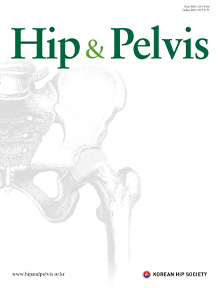Quick links
Related article in
-
Review ArticleSeptember 30, 2016
 0
0
 178
178
 26
26

Current Concepts of Using Large Femoral Heads in Total Hip Arthroplasty
Myung-Rae Cho, MD, Won Kee Choi, MD, Jae Jung Kim, MD
Hip Pelvis 2016; 28(3): 134-141AbstractInstability and dislocation after total hip arthroplasty are the most common causes of revisions and major complications for failure of inserted prostheses, leading to a reduction in quality of life. Because the use of artificial femoral head sizes smaller than patient’s own size is the important cause for dislocation, the use of large femoral head have increased. Femoral head sizes greater than 32 mm offer multiple advantages in physical function and activity levels of patients by improving hip stability, decreasing dislocation rate and increasing range of motion. However, various concerns are encountered including wear debris generation at the trunnion-bore interface and increases in frictional torque and stress over the component-bone interface when using larger head sizes. So, the use of femoral head sizes less than 40 mm is recommended. -
Original ArticleMarch 31, 2023
 0
0
 104
104
 25
25

Clinical and Functional Outcomes of the Exeter V40 Short Stem in Primary and Revision Arthroplasty: Does the Indication Affect Outcomes in the Short Term?
Nemandra Amir Sandiford, FRCS (Tr/Orth), Scott M. Bolam, MBChB, Irrum Afzal, MSc*
Hip Pelvis 2023; 35(1): 40-46 , Sarkhell Radha, FRCS (Tr/Orth)*AbstractPurpose: A variety of short Exeter stems designed specifically for use in performance of total hip arthroplasty (THA) in primary and revision settings have recently been introduced. Some have been used ‘off label’ for hip reconstruction. The aim of this study is to report clinical and radiological results from the Exeter V40 125 mm stem in performance of primary THA and revision THA.
, Sarkhell Radha, FRCS (Tr/Orth)*AbstractPurpose: A variety of short Exeter stems designed specifically for use in performance of total hip arthroplasty (THA) in primary and revision settings have recently been introduced. Some have been used ‘off label’ for hip reconstruction. The aim of this study is to report clinical and radiological results from the Exeter V40 125 mm stem in performance of primary THA and revision THA.
Materials and Methods: This study had a retrospective design. Insertion of 58 (24 primary, 34 revision) Exeter V40 125 mm stems was performed between 2015 and 2017. The minimum follow-up period was two years. Assessment of the Oxford hip score (OHS), EuroQol-5 Dimension (EQ-5D), and radiological follow-up was performed at one and two years.
Results: In the primary group, the preoperative, mean OHS was 13.29. The mean OHS was 32.86 and 23.39 at one-year and two-year post-surgery, respectively. The mean EQ-5D-3L scores were at 0.14, 0.59, and 0.35, preoperatively, at one-year follow-up and two-year follow-up, respectively. In the revision group, the mean preoperative OHS was 19.41. The mean OHS was 30.55 and 26.05 at one-year and two-year post-surgery, respectively. The mean EQ-5D-3L scores were 0.33, 0.61, and 0.48 preoperatively, at one-year follow-up and two-year follow- up, respectively. No progressive or new radiolucent lines were observed around any stem at the time of the final follow-up in all patients in both groups.
Conclusion: Encouraging results regarding use of Exeter V40 125 mm stems have been reported up to two years following surgery in primary and revision THA settings. -
Original ArticleSeptember 1, 2009
 0
0
 74
74
 14
14
Total Hip Arthroplasty Using a Large Femoral Head : The Short-Term Follow-up Results and the Early Complications
Myung-Rae Cho, MD, Se-Sik Kim, MD, Hyun-Seop Lee, MD
J Korean Hip Soc 2009; 21(3): 232-237AbstractPurpose: This study evaluated the short-term follow-up results after total hip arthroplasty with using a 36 mm large femoral head.
Materials and Methods: Between August 2004 and August 2007, 104 patients were treated with total hip arthroplasties using a 36 mm-Cobalt-Chrome femoral head with Longevity (Zimmer, Warsaw, IN) as the polyethylene liner. The average age at the time of the index operation was 61.4 years (range: 23 to 87 years), and the mean follow-up period was 27 months (range: 18 to 46 months). The clinical results and early complications after the operation were analyzed.
Results: The Harris Hip Scores were more than ‘Good’ in all cases with an average score of 93, and the Merle d’ Aubigne and Postel scores were more than ‘Good’ in 75% of the patients. All the femoral stems that were cemented or cementless had satisfactory fixation. Dislocation developed in one case and only one time, and there were no other complications during the follow-up period
Conclusion: Total hip arthroplasty with using a 36 mm large femoral head is a recommendable treatment with a low dislocation rate and high satisfaction, which comes from the lack of restriction of the postoperative hip position and movement.
- 1

Vol.36 No.1
Mar 01, 2024, pp. 1~75
Most Keyword
?
What is Most Keyword?
- It is most registrated keyword in articles at this journal during for 2 years.
Most View
-
Pathophysiology and Treatment of Gout Arthritis; including Gout Arthritis of Hip Joint: A Literature Review
Yonghan Cha, MD
Hip Pelvis 2024; 36(1): 1-11 , Jongwon Lee, MD
, Jongwon Lee, MD  , Wonsik Choy, MD
, Wonsik Choy, MD  , Jae Sun Lee, PhD*,†
, Jae Sun Lee, PhD*,†  , Hyun Hee Lee, MD‡
, Hyun Hee Lee, MD‡  , Dong-Sik Chae, MD‡
, Dong-Sik Chae, MD‡ 
-
Treatment of Osteoporosis after Hip Fracture: Survey of the Korean Hip Society
Jung-Wee Park, MD
Hip Pelvis 2024; 36(1): 62-69 , Je-Hyun Yoo, MD*
, Je-Hyun Yoo, MD*  , Young-Kyun Lee, MD
, Young-Kyun Lee, MD  , Jong-Seok Park, MD†
, Jong-Seok Park, MD†  , Ye-Yeon Won, MD‡
, Ye-Yeon Won, MD‡ 
Editorial Office
Laboratory tests performed in hip fracture patients. CTX: carboxy-terminal telopeptide of collagen I, PTH: parathyroid hormone, P1NP: procollagen type I N propeptide, U/A: urinalysis.|@|~(^,^)~|@|First-line treatment option for osteoporosis in hip fracture patients. BP: bisphosphonate, PTH: parathyroid hormone, SERM: selective estrogen receptor modulator.|@|~(^,^)~|@|Osteoporosis medication in patients with rebound phenomenon after cessation of denosumab. Ca+Vit. D: calcium and vitamin D, PTH: parathyroid hormone, SERM: selective estrogen receptor modulator.|@|~(^,^)~|@|The most important recognized factor for atypical femoral fracture.|@|~(^,^)~|@|Preferred osteoporosis medications after cessation of bisphosphonate in patients with atypical femoral fracture. PTH: parathyroid hormone, Ca+Vit. D: calcium and vitamin D, SERM: selective estrogen receptor modulator.|@|~(^,^)~|@|Preferred osteoporosis medications in patients with high-risk of atypical femoral fracture. Ca+Vit. D: calcium and vitamin D, SERM: selective estrogen receptor modulator, PTH: parathyroid hormone.
Hip Pelvis 2024;36:62~69 https://doi.org/10.5371/hp.2024.36.1.62
© H&P
© 2024. The Korean Hip Society. Powered by INFOrang Co., Ltd




 Cite
Cite PDF
PDF



